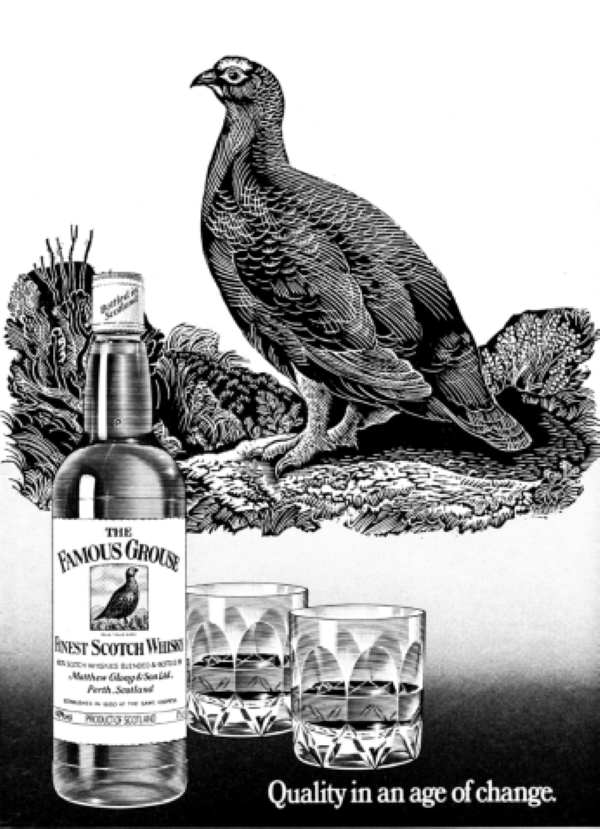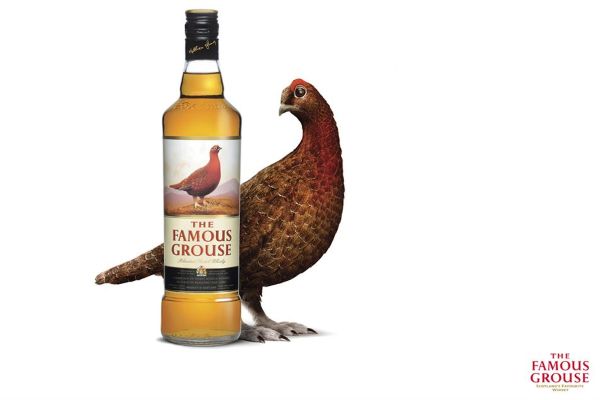Oh, to be Famous
During the 1970s The Famous Grouse soared past its rivals to become Scotland's favourite Scotch, and before long its 'plink plonk' animated ads became a staple of Christmas TV. Ian Fraser peers behind the label and ponders its future under new owners – William Grant & Sons …
On July 1st there was a flurry of social media activity from William Grant & Sons and some of its key staff on the day that the Bellshill-based company cemented its acquisition of The Famous Grouse and Naked Malt brands from the Edrington Group.
Some of the seemingly orchestrated posts welcomed the Famous Grouse into the Wm Grants' fold, using phrases such as "Happy Grouse Day!" and "The Grouse has landed!", while internal activities ranged from "special lunches" to "nosing sessions" and "lots of selfies", in some of which the Grouse (or someone dressed up in a grouse suit) made a cameo appearance.
In a statement, Wm Grant's Danish-born CEO Søren Hagh praised the "strong foundation" built up by Grouse's former owner while vowing to transform the avian brand into "a true global icon".
However, since "Grouse Day" Grant's has gone remarkably quiet about its plans for the brand. All there has been is a few social media posts on platforms like Instagram, Facebook, with the most recent being a video in which a Mancunian social media "influencer" named Eloise Preen prepares a Grouse & ginger cocktail on video. In a related development it also emerged that Wm Grant's has appointed Colette Noé – who worked for Diageo (2000-14) before joining Grant's in 2021 – as global head of marketing for the newly acquired brand.
Launched in 1897 by Perth-based wine merchant Matthew Gloag, The Famous Grouse was initially aimed at the hunting, fishing, and shooting set, with Gloag's daughter Phillippa drawing the first game bird for the label.

In 1970, when annual sales had reached 25,000 cases, the Gloag family sold out to Highland Distillers who appointed Saatchi & Saatchi to help build the brand. By 1980, the Grouse had become the biggest-selling whisky in Scotland – a position it has held more or less ever since, something that enhances its credibility abroad. However, according to Kantar data, it was overtaken by Whyte & Mackay in Scotland last year. The Grouse has also periodically been number-one-selling Scotch in the UK, after winning battles for retail shelf space with own-label and cut-price blends.
Despite Saatchi's reputation for iconoclasm, the adverts remained resolutely staid and traditional – usually showing a grouse in its natural habitat, using slogans such as "Quality in an age of change" and "Raised in the Highlands". Fearing that the Grouse might risk extinction if it didn't seek to win over younger drinkers, marketing director Bill Farrar, is credited with shaking things up. Abbott Mead Vickers (AMV) was picked to replace Saatchi's in 1995, and by 1997 Grouse was on TV for the first time.
AMV developed a string of wry 20-second commercials, in which a somewhat blasé animated grouse arches its eyebrow and performs arabesques, and which played on phrases used by drinkers such as "have a double" or "have a swift one", all to the tune of "Plink Plonk", which started life as a medley of assorted whisky sounds. Using CGI techniques perfected for "Walking With Dinosaurs," the ads brought the feathered "icon" to life and into the modern era. Over the next 28 years the campaign, heavily weighted towards Christmas, remained remarkably consistent. Indeed, it might even be the most consistent campaign for any Scotch whisky.

Reviewing the initial ads in 1997, ex-creative director of Grey Advertising Tim Mellors said: "These ads are really terrific. Simple and utterly charming, their economy in production cost only helps the gentle economy of the wit." They were also highly effective. "At half the cost of running the campaign, we achieved the same level of awareness as any other whisky campaign", claimed Farrar in Charlie Maclean's book 'Famous For A Reason'.
The approach survived Edrington's £601m takeover of Highland Distillers in November 1999, though Edrington and AMV later changed the slogan to "Famous for a reason," in an ad featuring a blinged-up Chihuahua. In 2002, Edrington opened its £2.5m Famous Grouse Experience at the Glenturret distillery, partly with a view to converting overseas visitors into "ambassadors" for the brand. In 2010, the packaging was "refreshed" with the bird redrawn by artist Rodger McPhail but given greater prominence. The packaging was again revised in 2018.
The recipe for the Grouse is believed to include The Macallan and Highland Park among malts, with around 65% of the blend made up of grain whisky. American and European oak is used for the casks, which are sherry-seasoned in Spain before arriving in Scotland for maturation use. Whether this will continue under Wm Grant's ownership remains to be seen.
Over the years, a range of expressions and variants have been developed, including blended malts, single malts, and aged blends. The peated Black Grouse, since renamed 'Smoky Black', was developed for the Swedish market in 2006. Other current variants include Sherry Cask Finish, Ruby Cask, and The Famous One – offering a sweeter, more honeyed flavour. The brand has also invested heavily in sports sponsorship, inclusive of the Scotland rugby teams and 2014 Commonwealth Games and got into personalized labels.
AMV was forced to resign the advertising account in 2015 due to a conflict with its recently-won Bacardi client, enabling the Leith Agency to take over the advertising reins. The agency refreshed the campaign by ditching the non-descript backdrops and bringing the grouse back to its native Scotland, with ads such as "Perfectly balanced" (2016) and "Smooth" (2018). In the latest TV commercial, "Full of Character" (2023), which has been aired in over 30 countries, the eponymous bird is shown in a more contemporary setting, seemingly emulating the uselessness of Mr Bean as it prepares for a dinner party. Edrington said this commercial is directed at "the next generation of whisky consumers," with a view to educating them about Grouse's "mixability and accessibility".

Worldwide, Wm Grant's claims Grouse sells 2.7m cases a year, down from over 3m in the 2010s – with 45% of those sales in the UK. Top export markets include Sweden, Poland, the US, and the Netherlands. Some commentators have questioned how it will co-exist with Wm Grant's eponymous Grant's blend, which outsells it by a factor of 2:1. Maybe the company will seek to segment the blended market like Pernod with Ballantine's, Chivas Regal and Royal Salute – with Grouse pitched at a higher price point to Grant's.
But what of the ad campaign? Should Wm Grant's consider a change of tack after 28 years of "Gilbert The Grouse"? Not according to the creatives I spoke to. Gerry Farrell, co-founder of Gerry Farrell Ink, and former creative director of Leith, says: "There's a ton of brand equity in the grouse icon. When it's brought cleverly to life in film, it gives the brand charm and wit. Woe betides the marketing team that throws that in the bin."
Mick Mahoney, ex creative director at Lowe Howard-Spink, BBH London, Y&R and Ogilvy, said: "If your brand mascot is a characterful grouse, your packaging features a grouse, your name is Famous Grouse, and you've spent 28 years trenchantly plugging a grouse in your advertising, then it would seem like a wilful act of self-sabotage to junk it. The opportunity is to drop the whimsical executions that make it feel like a retired bank manager's cheeky midweek tipple and find a new space for it in the ever-evolving world of drinking occasions."

Ian Fraser is a financial journalist, a former business editor of Sunday Times Scotland, and author of Shredded: Inside RBS The Bank That Broke Britain.
